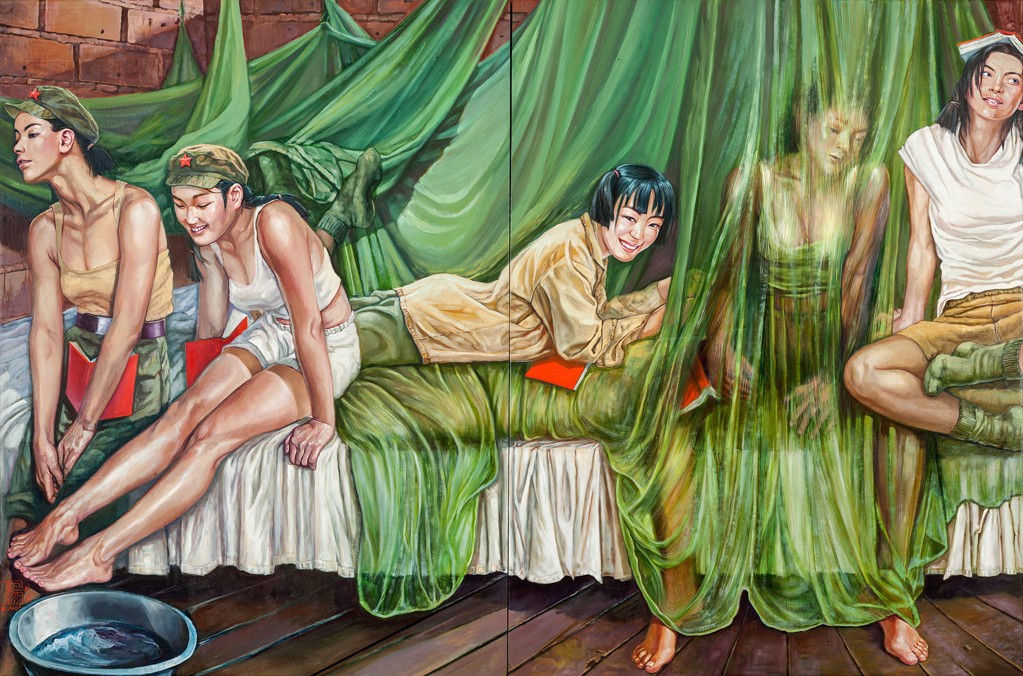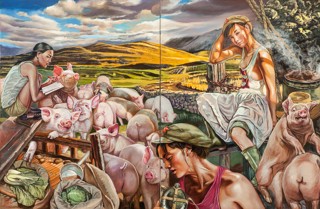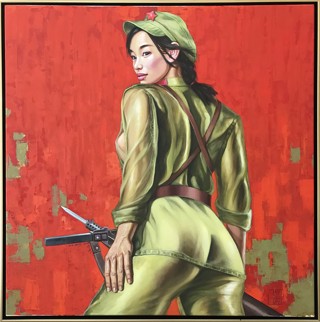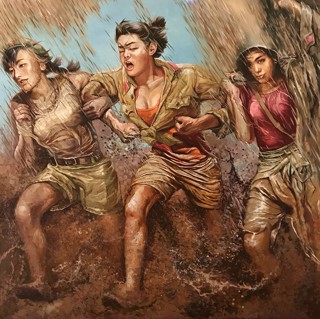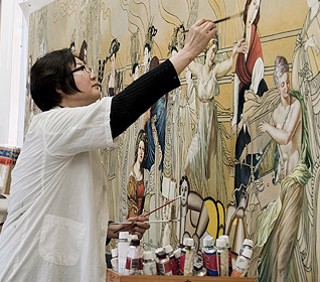
Hu Ming Biography
Hu Ming's ancestors belong to ancient Mongolia. It is said, they were sent to Liao Cheng Shan Dong Province in the early Han Dynasty. Till this day there are about ten families and their surnames are still Hu. Hu Ming's parents were doctors and served in the army. When Hu Ming was a little girl, her parents always told her "You have the hands of an eye surgeon we hope you will be a doctor". However Hu Ming took no interest in it, she only wanted to paint. While she was in high school the Chinese Cultural Revolution was in full swing. Consequently because her teacher knew Hu Ming like to draw, he let her draw Chairman Mao's portrait. However Hu Ming's mother was very concerned about this and mentioned to her daughter "If you cannot draw Chairman Mao's portrait precisely then it will be big trouble for our family, you may even be placed in jail, so please daughter practice draft after draft, until you feel sure you can do it." During the Cultural Revolution in China, Hu Ming spent her school days either drawing Chairman Mao's portrait or memorizing his infamous red book, nothing else was allowed and Hu Ming found it very boring, so she begged her parents to let her enter the army, she was only 15 years old. As her parents were in the army it was not such a difficult task. So in 1970 she became a solider. She was stationed in an army hospital '254' in Tian Jin a hospital of 5000 people. Hu Ming's parents knew that their dream of their daughter becoming a surgeon was futile, as her family and ancestors come from a long line of artisans, masters in exquisite wood carving of Buddha's for the temples. While Hu Ming was serving in the army hospital, she had numerous postings. Starting as the hospital broadcaster/announcer, a librarian, and a lone projectionist, traveling with a truck, and the same eight movies to seven different locations. Often she was the only woman at these locations. While as the hospital announcer she found herself often in the commander's office, in trouble due to her careless mistakes. One night instead of the daily recorded wakeup bell at five in the morning, she played the call to arms at three in the morning! Everyone except Hu Ming assembled in the hospitals quadrangle expecting the worst, the commander knowing Hu Ming well went to her office to find her fast asleep. She loved her sleep at this stage and at this time everyone was required to read Chairman Mao's red book every morning between 7:30 till 8:30, however Ming would without fail fall asleep the moment she opened this book, she became notorious amongst her colleagues for being sound asleep every morning at this time and often would be found in dribble. People were starting to talk! Maybe she was losing her mind; she was not toeing the party line. Her commander at this time was a kind and wonderful man, who was a fatherly figure. At this time he called her into his office for a word ..."Ming he started, why is it that you fall asleep each morning, you must read Chairman Mao's book?" Ming replied "Sir I cannot help it, every time I open this book I fall asleep, it is so boring, if it were a story book then I would have no trouble". "Ming he bellowed you must never say this again to anyone! As you would be in serious trouble. He then reached over and gave her a tub of tiger balm and told her to rub a little into her temples each morning at this time, and which he hoped would help her stay awake. Fortunately this did work for Ming and not too soon as her compatriots were starting to talk about her. However Ming loved her sleep at this time as it not only gave her a kind of refuge, but a place to dream and use her imagination. To this day she still paints many people asleep. In retrospection she say's that nobody was 'talking real' during this period of the Cultural Revolution, and it was very dangerous to speak one's truth, as any dissent would end in a jail sentence. Her commander also gave her a clock, as to not sleep through and miss the time she was to play the morning bell. Ming slept with this clock for 6 years; however she still had trouble sleeping in and not hearing the alarm, or just setting the alarm to the wrong hour! Her time as a Librarian was a godsend for Ming, and changed her most profoundly. During the cultural revolution, people were only to read Chairman Mao's red book, or his poetry, or some history that was of the "right" sway...all other books were banned, and most were burnt in huge bon fires, yet for some reason of the three truck loads of books that arrived at the hospital, they decided not to burn the last load, and it was Ming's task to categorize three rooms of books piled a metre high on the floors. She was not allowed to read the books of course, but when she found amongst the mounds of books, classics from Tolstoy to the story of Oliver, she read everything she could get her hands on! She also found records of classical music...the library became a wondrous place for her she would awaken whilst within its walls and fall asleep once she returned to the outside world of the cultural revolution. She would also to much peril smuggle some of the books out of the library under her shirt to give to her girlfriends, and would sit around with them and play some of wonderful music she found. However it was one day in that library that she found a book that would change her life forever, it was an life drawing book by Michelangelo a book of human anatomy, the figures were of men, and it was the first time for the now 16year old to see the nude. She was in a mental turmoil as she was both absolutely fascinated, yet petrified, as to be found with this would be serious. However despite the danger she took the book back to her room to study and copy the drawings, so she might be able to draw the human body so well. She kept the book in her pillow, along with her underwear and bra's as it was just a convenient place to keep them, though one day she discovered to her horror that both the book and her underwear were gone. Ming was in shock; she knew the consequences and wondered who it could have been. She instantly thought of the only man to have a key to her room, and she also knew that there were men around that deliberately stole women's underwear. Then one day her commander called her into his office, in a voice, that could not be mistaken, she sits down and he places the book in front of her and demands to know where she got this! "From the library" replied Ming. "Ming he said there are naked male images in this book, they are wearing no clothes! And you have copied these images as well! Why to you like this kind of material"? {This kind of book was considered pornographic at this time} Ming was very scared and started to cry, and she also started to believe that she had a problem, she thought to her self that maybe everyone was right "I'm not mentally well" but she retorted "please do not tell my parents" The commander never reported the incident, however the book was never seen again and the underwear was stolen by another person, whom Ming was sure to be her immediate boss ( an ex-pilot ) as he had one of two key's to her room. From that time on she kept her underwear inside her pillow. The cultural revolution required men and women to be homogeneous, women were not to display their femineity or to wear face cream that contained any perfume, Ming did not see shampoo until the mid 1980's , hence the womanliness of her army girls in her painting. In 1976 her commander sends her to train as a nurse for three months, during this time, Ming wins a prize for her work as a story teller with her hand-painted animation slides. The nurse training was tough as her teacher was a strict disciplinarian and demanded much from her trainees. Ming soon discovered that the sight of running blood was not for her fainted thrice during a caesarean birth. However she found she could stay in the morgue without much trouble, to the utter surprise of the other nurses who detested the dead bodies, and would ask Ming to accompany them. Hu Ming made the most of this time to study the anatomy of the dead bodies, she learnt how the muscles wrap around the bone and that formaldehyde would turn men red and woman green...Her training also involved the correct use and application of hypodermic needles. And to learn this technique she was made to practice on herself with a saline solution. After the training was completed she was sent to a "real hospital" to administer needles to the soldiers. She was placed in the male section where scores of men lined up to receive their medication, She found the young soldiers to be shy, which made for the needle application to be difficult, she would ask them to relax, however this only made them to become ever more tense, as the needle was administered in the bottom, a slap or a tickle would not work either, so she resorted to the surprise treatment. Some men were not shy at all, and would drop their pants, to which Ming was greatly annoyed and consequently drew a description of the correct portion of the behind was to be revealed. Ming continued this job for a year and this could be a reason for her prevalence of bottoms in her painting. Ming while very capable at the needle application was not so good at the mixing the preparations, so she changed positions to work with the burn victims, which was not a popular job with the other nurses, it was ok for Ming and she was given two keys one to the morgue and one to the drug cabinet. A very big responsibility. A specialist surgeon happen to notice that Ming was very good with her hands and eyes and offered her a position with his surgery (a skin clinic attached to the burn unit) However the work was gruesome as the skin graphs came from the bodies of recently deceased infants, as the skin was the most suitable for transplants. Ming's job was collecting the babies from the other side of the hospital in a bag, then to remove the skin within 72 hours from the baby prepare it and store. The corpse was then carried at night to the vegetable garden and buried. The first time she did this she threw up and consequently buried three or four babies at a time. This surgery did manage to save many lives of the burn victims. The first 6 years Ming was chosen out of 200 hundred people to be part of the political wing of the hospital... which included the administration/ Library/ and office. It was an exercise in pure propaganda During this time as a nurse Ming witnesses daily the dead and withered bodies of illness, so consequently she loves to paint the healthy voluptuous bodies. She came to hate the view of an ill body. In 1976 a massive earthquake in Tang Quan province, Ming was sent there her role was to organize and catalogue the immeasurable dead bodies another time surrounded by death. It was this time that it became too much for Ming to be constantly encircled surrounded by death and subsequently told her commander that she wanted out of the army. However he could not bear to lose her and said that she could choose her next post. So in the proceed years she began to study and produce propaganda films for the red army...and during this time she won a major art prize for a painting of a female soldier " the best in the army" she was the hero of the hospital 245 and given another rank. In 1979 Ming goes to University She told her commander that she wanted to leave the army for study she was hungry for art skills...Boss said no we need you in the army...but you can go to Tein Jinn. So consequently she remained in the army while attending university. Ming sat for the entrance exams and passed with flying colours- and only just made the age cut off requirement of 25 years. While at university there was a compulsory politics module, which had to be pass to complete the University course. However while Ming would consist score in the 90's for her art she consonantly failed the politics component, which cause a ruckus amongst the facility, to the point that a lecture went to see her commander to discuss Ming's state of mind. Her commander once again stood up for Ming and relayed that Ming was fine despite a very bad memory. By his admission she was able to pass her university exams. Her university life was very rigorous she would study till midnight then up at 5:30 to exercise and consequently won a scholarship and for 3 years studied very hard In 1982/3 she bought her first camera. And instead of traveling home in her holidays as did the other students she would travel alone to the mountains in the North to visit the local villages and consequently hitching around the country. 1982 her whole class was assigned to copy the famous cave paintings of the Buddhists grotto temples-5000 years old. It took 6 months and 6 artists to copy these famous and important paintings onto rice paper working with only a simple battery torch to see inside the caves. The entire reproduction of these paintings is now at the university the area around the caves was very poor, there were no vegetables save but onions. This time in the caves was extremely important/invaluable to Ming's training as it was the traditional line style of drawing. At this time Ming kept 3 wishes that she wanted to materialize in her life… To continue to study art. To travel to different countries and especially to see Michelangelo. To be wealthy enough to start an arts university. Till this day there are 23 of Ming's art works in the university’s gallery. Ming was the dux at the arts facility in her university. In 1983 for her final work for graduation, she had to paint a picture and was given she had 3 months to do it and could travel anywhere in China. Ming choose to live on the silk road in the north of China at the start of the Great wall in the Chang Chi province. She found a room with an old lady who smoked and drank in continuance, her home had no electricity or running water, and Ming would have to walk with a bucket each morning in the snow to collect some. At this time in the village the Chinese New Year was in progress and the village men would dance and drum and this became her topic and she painted a 2metre square painting entitled "Mountain Kin and River" She then went back to university for graduation. In 1983 she returned to the army hospital 254 and went back to the political office she had originally started at. She was now given another rank and was given the position of the art club and culture boss, which included the family planning division and the distribution of condoms. She remained in then army for another year when it became too much for her and she told her boss that it was time to leave, he said if you stay you can have any position you wish. Ming choose the army film factory, which specialized in propaganda war films, typically about the red armies victories over the Japanese imperialists, during world war II the Japanese invasion and occupation.. The films typically featured the killing of Japanese soldiers with bombs/ fire/ etc. Now she was in charge of making and mixing fake blood, instead of the real thing in hospital 254. She was the creative director working with props and special effects. She tried her hand at writing and directing films and one was about to go into production, however a story about Mao's life as a boy was made instead, however the story was published in a movie magazine. She worked with the army films for five years, and was on her way to be a director and was given the rank of Major, which included a 3 bed house. But her heart was not in it any longer, and at this time China opened its doors to its citizens consequently saw an opportunity to study English in New Zealand and she took it. And so her life in the Chinese red army game to an end after 20 years. This was around the time of the Tiananmen Square killings was in the mountains making a movie. The pressure of these times was too high, she recalls the propaganda was rife; no one could speak their minds for fear of persecution. Her first Husband was a dissonant a magazine editor who fled to NY and continued to write about the Chinese Government. While studying in NZ she would draw faces at the markets in Auckland, then a man from Warner Bros saw her and asked if she would like to work for him, which she did foe a year till an opportunity game to paint full time in her own studio and so she started her own gallery and studio Anzac Parade in Auckland in 1993. This was her first time to use oil's and canvas; previously she had only used Chinese brush on rice paper and water colour. She fell in love with the oil colour immediately and has never returned to the water colour. Things as they do change and she was drawn to Australia and so in 1999 she came to Australia and found work with the Chinese post editorial board for a year, but has since met a partner who was able to give her the time to once again paint full time. There is a new face in the wave of Asian Artists breaking on our shores ... Hu Ming. She is a pioneer in her field being diverse in combining both modem and classical styles. There is a blend of exotic, strange, humorous and above all mysterious in her art. She merges a conscious sense of post modernism and element of sub-culturalism. Her paintings express dearly her worship of the female form depicting both physical strength and feminine beauty. Her works are not of a planned process born of her dreams and represents an accumulation of her diverse experiences. She has held exhibitions in China, Japan and Singapore and of course in Sydney with Wentworth Galleries. Ming’s paintings are collected throughout the US, Canada, Asia and Europe.
Select Archive Works

